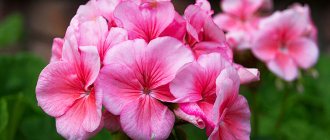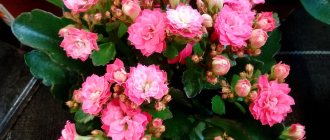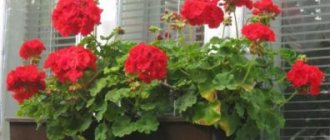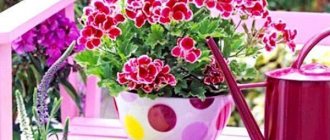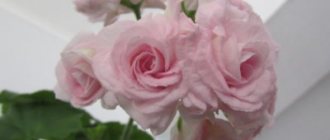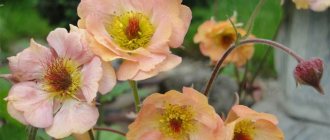Will geranium (pelargonium) survive winter in open ground?
In particular, I wonder if it makes sense to plant this flower in a cemetery, for example?
Does anyone have a similar experience? Geranium will not survive frost above ten if there is no snow. Plant periwinkle or alpine violet. You can plant tulips, they also grow normally and do not freeze. Mom planted geraniums on my grandmother’s grave three times, although our winters have been warm lately, there is no snow, and for two or three days there was a frost of -15, everything froze. I really thought they might have dug it up. But mom says no. This year they didn’t plant any more. But the violet grew like a weed. Grandfather loved strawberries, I planted a couple of strawberry bushes there, and the violet killed the strawberries.
In his question, the respected author did not indicate his region of residence. And this is important for the answer.
Pelargonium zonalis or geranium is a very common indoor flowering plant, generally quite unpretentious, but it is not a frost-resistant crop.
This means that sub-zero temperatures are detrimental to it. We are not even talking about severe frosts (-10 and below), which, in general, are typical for central Russia in winter. The usual -1 - -2, and in a couple of days the geranium will die, it will not grow back from the root in the spring, there is no point in hoping. Shelter is unlikely to help.
If in your region the air temperature does not drop in winter, for example, below +5 - +7, then geraniums have a chance to survive the winter, although small, but there is a chance.
I think that even in winter, in a state of semi-dormancy, temperatures below +10 - +12 are destructive for this plant.
Pelargonium, which comes from South Africa, is grown in our country exclusively as a houseplant or greenhouse plant; only in the summer after frost is it planted in the garden if desired. Pelargonium overwinters well in bright, frost-free rooms at temperatures not lower than +6 degrees. A snowdrift, no matter how high it is, will only destroy this plant.
In the cemetery, unpretentious plants are grown that do not require constant care: watering, pruning, fertilizing. Plants are selected depending on the conditions of the planting site. For example, under the canopy of trees, where it is always humid and there is no scorching sun, you can plant lilies of the valley, in sunnier areas - bulbous ones that do not require digging and drying the bulbs in the summer, for example, daffodils. Without any supervision, you can grow the well-known young and various types of sedums.
Geranium: planting, care and wintering
Geranium (pelargonium) is considered a classic among indoor and balcony plants, because its lush growth and flowering creates a real symphony of colors. In summer, geraniums decorate window sills, terraces and gardens, shining with colorful and bewitching flowers, and in winter, with good care and compliance with several important criteria, they can survive the winter without problems.
Origin of geranium
Currently, in gardening centers you can buy a wide variety of geranium varieties, amazing in the variety of shades and sizes of flowers and leaves, which were mainly bred by crossing several original species. The original parent species are native to South Africa, where they are part of the Cape Town flora (with 230 species of about 250–300 known), and from California, Australia and New Zealand.
Geranium was first mentioned by the Greek physician Dioscorides in his book on medicinal plants. Thanks to Dutch sailors at the beginning of the 17th century, the plant began to spread from South Africa to Europe, which soon became its second home. The most famous species - ivy-leaved pelargonium (Pelargonium peltatum) and zonal pelargonium (Pelargonium zonale) were brought to Europe between 1699 and 1706 by the Dutch governor of the Cape Province, Adrian van der Stel. Soon, due to the great passion for this plant, several reconnaissance expeditions were sent to South Africa, thanks to which the geranium trade began to gain more and more popularity.
Usage
Due to the beauty of its flowers and decorative leaves, pelargonium is most popular as a balcony plant, which looks great in both single and combined plantings. Geraniums also look great in the garden and on the terrace, in small and large containers. Some species (varieties of star pelargonium) are ideal for growing in flowerpots, being a real decoration for a relaxation area on a terrace or balcony.
A good decorative effect is created with properly selected companion plants. So, almost all ampelous or erect balcony flowers go well with geranium. The simplest combination is geraniums of two different colors (for example, pink and raspberry), which create a wonderful color harmony. If you want more variety, matching verbena, bacopa or nemesia will do the trick. As you can see, there are no boundaries that would limit the creative use of geraniums, however, before planting, you should make sure that the partner plants have similar properties, which will simplify further care. For example, geranium loves warmth and a lot of sun, so to create a Mediterranean style, heat-loving sage, rosemary, lavender, daisies or yarrow would be good companions.
Location
Pelargonium needs soil that is rich in nutrients. As for the planting location, both sunny and partially shaded areas are suitable. The following rule applies: the more sunlight the plant receives, the more flowers are formed. A light breeze will not cause any harm, but strong gusts may break long branches. Pelargonium varieties with large flowers should be protected from rain.
Planting substrate
On sale you can find a special planting substrate for geraniums, which initially contains the right combination of nutrients. However, if you plant several specimens, the costs can be significant. In this case, it makes sense to prepare your own soil mixture, consisting of 20% compost, 30% peat and 50% garden soil.
Planting geraniums
It is best to transplant store-bought specimens into a larger container as soon as possible. In this case, you need to act very carefully so that the young roots are not damaged.
READ ALSO: How to properly water succulents
• The pot must have a drainage hole. It is also never a bad idea to put a layer of drainage material on the bottom. • Then add a layer of soil, plant the plant (if necessary, shorten long or damaged roots), cover with substrate, press lightly and water. • When planting geraniums in balcony boxes, do not plant the plants too tightly, otherwise they will compete as they grow.
Watering and fertilizing
Geraniums need sufficient water and nutrients. In summer, more abundant watering and fertilization are required to extend the duration and quality of flowering.
• Never water the leaves! • Water in the morning and evening if it is very hot and there is a lot of sun, otherwise morning is best. • Rainwater is ideal for irrigation. • Pelargonium does not tolerate waterlogging of the soil, so excess irrigation or rainwater must be removed from the pan in time. • Temporary drought will not harm the plant, but flowering will be less abundant. • Limit watering during rest periods, but make sure the root ball never gets too dry. • As a top dressing, you can use long-acting fertilizer or liquid complex fertilizer (once a week). • Use nitrogen fertilizer for growth, potassium for flowering, and magnesium for lush green leaves and stems. • Geraniums grown in pots and boxes need a lot of nutrients because the plant only gets them from a limited amount of soil.
Trimming
Geraniums do not need regular pruning, but as the plant grows it becomes bald underneath and may require extensive pruning every few years. Pelargonium, as a rule, easily tolerates pruning, which is best done in the fall before wintering. Also be sure to remove faded flowers, buds, and very long, dried out or damaged shoots.
Wintering
Since geraniums come from regions with warm climates, in the fall, when most of the leaves turn orange-brown or the daily temperature is close to negative values, the plant should be moved to a safe place for the winter.
• Trim the shoots by approximately 1/3 to 2/3 so that the plant height does not exceed 17-20 cm. There should be 2 to 3 thickened nodes on each side shoot. • Remove excess soil that is present at the roots, but the fine roots should remain in the soil.
Wintering options
Depending on the available space, geraniums can overwinter with an open root system or in a pot.
1. Plastic bag method
Many amateur gardeners choose the so-called “plastic bag method,” when geraniums are placed in a bag and hung upside down. To do this, you first need to shorten all the long roots to the same length, then wrap the root ball in newspaper and place it in a thin plastic bag with holes to ensure good ventilation.
2. Wintering in a pot
After pruning, clear the root ball of excess soil and plant 3-4 small plants per pot. Cover the roots with a mixture of potting soil and sand.
Features of winter care
• During the wintering period, geranium does not require special care. However, while a plant in a plastic bag will survive the cold season without water, a geranium in a flower container should be watered sparingly every few weeks to prevent the soil from drying out and the plant dying. • Fertilizers should be avoided completely during winter, but the plant should be checked regularly for pests. • Geraniums in pots are best left to overwinter at a temperature of 5 to 10 degrees in a bright place. The following rule applies: the darker the room, the lower the temperature should be. If the plant overwinters in a place that is too warm or too dark, it can not only sprout prematurely, but also form long, thin shoots. • If the geranium has successfully survived the winter, you need to work hard to prepare it for summer. Thus, if necessary, the plant is trimmed again, replanted and moved to a sunny place on the windowsill in order to gradually adapt to new conditions.
READ ALSO: Never repeat these mistakes in caring for your orchid! The most dangerous mistakes when growing tropical orchids at home
Geranium propagation
Pelargonium can be easily grown from seeds, however this method takes longer, so cuttings are preferable. This propagation method is not complicated and is ideal for those who do not have a place to overwinter old plants.
• The best time is autumn, then next year you will have new flowering specimens. • Take cuttings about 10 cm long, cut the stem diagonally, remove the lower leaves, as well as flowers and buds. • Insert the free end of the stem into moist planting soil and place the container in a cool, dry place. • In early spring, move the plant to a warmer, well-lit area. • To encourage geraniums to develop side branches, break off the tips of the shoots.
Diseases and pests
When grown outdoors or indoors, geranium can suffer from a number of diseases and some pests.
1. Bacterial disease
If a geranium is affected by a bacterial disease or bacterial wilt, the infection may have already been present in the plant at the time of purchase or cultivation.
• Oily but clear spots form on the leaves. • Affected areas dry out, turn black and die.
Immediately remove the affected parts of the plant and treat with a fungicide. As a preventive measure, do not apply too much fertilizer and water, and avoid damaging shoots and leaves.
2. Geranium rust
The most common disease affecting geranium stems is a fungal infection known as geranium rust. The leaves turn yellow or brown. The disease is very contagious, quickly spreading to other plants, so always make sure that no moisture falls on the leaves and stems when watering.
3. Gray mold
Another disease that geraniums often suffer from is gray rot or gray mold, which appears as black spots with a gray mushroom lawn. The reason is too much watering, damage to parts of the plant, too cold weather and lack of light. In case of disease, the affected leaves must be removed and the plant treated with a fungicide.
4. Iron deficiency
The disease manifests itself in yellowish leaves with green axils. Iron deficiency is not dangerous for geraniums, but the reason lies in the lack of nutrients, so do not forget about regular feeding with complex fertilizers.
5. Aphids, thrips and spider mites
Pests most often attack the plant due to improper care or unfavorable weather conditions. To get rid of spider mites, thrips and aphids, geraniums can be treated with a solution of green soap. In case of mass infestation, the affected areas should be removed as a precaution and an appropriate chemical should be used.
Don't be careful with geraniums!
Do you want to shade the roses and fill the voids between the bushes, add color or, conversely, smooth out the diversity along the path? Take a closer look at geraniums and invite these wonderful flowers into your garden. They will help. There are many types and varieties. Answers to the most frequently asked questions about growing geraniums were prepared by Svetlana Kolobovnikova, the owner of a large collection of species and varietal geraniums.
Love at first sight with geraniums (Geranium) did not work out in our country. But bright, big-eyed flowers are still trying to reach the hearts of flower growers; surprise with their unpretentiousness, resistance to disease, undemandingness to soils, long flowering periods, large, up to 5 cm in diameter, flowers (in the magnificent geranium, G. x magnificum), amazingly miniature rosettes (in the ashen geranium, G. cinereum), double flowers (in Himalayan geraniums, G. himalayense, and meadow geraniums, G. pratense), color and unusual structure of leaves (in red-brown geraniums, G. phaeum). With a minimum of care - maximum pleasure. Just give it time! So, what worries you when choosing geraniums?
Possible problems and illnesses
When growing geraniums, the following problems are possible:
- Geranium does not bloom. Most often, the lack of flowering in geraniums is the result of untimely molding of the crown.
To prevent this from happening, the plant needs to be pruned regularly to encourage flowering. There are also other reasons: low air temperature or lack of lighting, too fertile soil, too deep a planting hole, as a result of which the roots begin to actively grow, but it does not have the strength to flower, there are few nutritional components in the soil due to the lack of fertilizing. - The leaves are turning yellow. This problem is very common, and the following reasons can affect it: if the leaves turn yellow and begin to dry at the edges, then the plant does not have enough moisture, if the leaves turn yellow and wither, then the reasons are excess moisture, yellowing of the lower leaves and their gradual falling off indicates about a lack of lighting, if the leaves turn yellow after transplantation, then this indicates the adaptation of the plant (read about geranium transplants here).
Geranium is one of those plants that rarely get sick and suffer from pest attacks. The following problems occur extremely rarely:
- Gray rot. It damages exclusively the leaf plate of the plant. It is necessary to immediately remove diseased leaves and stop watering. Finally, the geranium is treated with antifungal drugs.
- Root rot. It develops when the soil is frequently moistened, when the earth ball has not yet had time to dry out in the pot (read about the features of growing geraniums in a pot here). It will no longer be possible to save the plant; you need to get rid of it, and treat the soil in which the flower grew with a solution of potassium permanganate.
- Aphid. This pest can be green, gray or black. It is focused on the inside of the leaf plate. To get rid of the parasite, you need to use an insecticide, and the instructions will help you determine the dosage of the drug.
- Powdery mildew. This is a fungal disease in which the leaves and stems become covered with a white coating that resembles flour. The main reason for the development of the disease lies in high humidity. To defeat the disease, it is necessary to use a solution of copper sulfate and ammonium nitrate 0.5%.
You can grow geranium outdoors as an annual plant. There is nothing complicated about this, since this flower is not picky. It is important to provide it with adequate and regular watering, timely fertilizing and preventive measures against diseases and pests.
Will this geranium overwinter outdoors?
Some types of geraniums are native Russian plants and decorate our forests and meadows. Which, by the way, often and completely unfairly turns people away from this culture. The following species overwinter in the open ground without problems: magnificent geranium, Himalayan geranium, Dalmatian geranium (G. dalmaticum), red-brown, blood-red (G. sanguineum), macrorhizum (G. macrorhizum), Cantabrigen geranium (G. x cantabrigiense), Clarke (G. сlarkei), forest (G. sylvaticum), meadow, small-stamen (G. psilostemon), oxon (G. x oxonianum), spotted (G. maculatum), ash, Renard (G. renardii), Farrera (G. farreri), erianthum (G. erianthum). Some hybrid varieties, for example “Blue Blood”, “Patricia”, “Salome”, “Ann Folkard”, “Sue Crug”, winter well under snow cover, but there is some risk when growing them, since there are frosts on bare ground in autumn . And under cover there is a danger of damping off. However, flower growers have been successfully growing these varieties for several years now.
For color ideas - dark-leaved varieties
Meadow geranium has several varieties with dark burgundy almost black foliage. It started with the variety "Victor Reiter", but it does not have the darkest foliage. Varieties of the same meadow geranium, different in height, are very decorative: “Midnigth Reiter”, “O’key Dokey”, “Hocus Pocus”, “Black Beauty”, “Purple Heron”. The blue-blue rather large flowers look harmonious with their carved leaves. Varieties with brown foliage of spotted geranium have appeared - “Espresso” and “Elizabeth Ann”. Red-brown geranium pleases with purple-brown spots on a dark green background of carved leaves. The Samobor variety is especially good. Here the foliage dominates, the flowers are much more modest.
Plant in sun or shade
In an open sunny place, Dalmatian, East Tibetan (G. orientalitibeticum, despite its origin, has been wintering in the middle zone for several years), Ash, Farrera, Renarda geraniums feel good. These are all low geraniums. Conversely, magnificent, forest, red-brown, blood-red, marsh (G. palustre), large-rhizomatous, and small-stamen varieties grow well in partial shade and even in the shade.
Marsh, red-brown and Endres geraniums tolerate excess moisture well. Himalayan, Dalmatian, large-rhizome, ash, and Cantobrigen geraniums tolerate dry soil.
But it is better not to experiment, but to provide normal watering to the plants.
You need a lot of geraniums, you will have to propagate them
All methods of propagating geraniums are good. Most often, the bush is divided in the spring. In geraniums that are difficult to disassemble into segments (this is especially true for the varieties “Ann Folkard”, “Patricia”, “Rosanna”, as well as varieties of ash geranium), you can separate a young shoot without roots, as they say, with a heel and, removing it from Most of the leaves can be planted in a greenhouse, or just under a jar. After 2-4 weeks, the plant will take root and be ready to be transplanted to a permanent location.
You can cut root cuttings of geraniums in the spring, treat them with Kornevin and place them in a greenhouse until leaves form. This is the best way to propagate blood-red geranium.
LiveInternetLiveInternet
—Categories
- Everything for a diary (63)
- Crochet (870)
- Children (12)
- Jackets, pullovers (298)
- Rugs (8)
- Dresses (55)
- Blankets, ruffles (58)
- Potholders (1)
- Napkins (28)
- Tablecloths (73)
- Bags (49)
- Slippers (7)
- Top (78)
- Patterns, training (182)
- Shawls, ponchos (44)
- Hats, berets (3)
- Skirts (41)
- Knitting (830)
- We knit for men (19)
- Dress (31)
- Pullovers, jackets (455)
- Napkins, tablecloths (8)
- Bags (4)
- Slippers (24)
- Tops (41)
- Patterns, training (153)
- Shawls, stoles (72)
- Hats, berets (24)
- Skirts (14)
- Dacha (222)
- Diseases, pests (14)
- Grapes (3)
- Hibiscus (4)
- Arrangement (37)
- Vegetables (25)
- Pelargoniums (25)
- Fruit (8)
- Fertilizers (8)
- Flowers (107)
- Berries (7)
- ZhZL (9)
- Health (87)
- Beauty (101)
- Cooking (2123)
- Pancakes (7)
- Microwave (28)
- In a slow cooker (21)
- Jam, jam (65)
- Sweet pastries (6)
- Desserts (144)
- Snacks (165)
- Candy (112)
- Dairy products (39)
- Seafood (19)
- Meat (306)
- Alcoholic drinks (64)
- Vegetables, mushrooms (131)
- Pasta (12)
- Cookies (110)
- Unsweetened pies, flatbreads (105)
- Sweet pies, cupcakes (261)
- Unsweetened pies (61)
- Cakes (63)
- Fish (81)
- Salads (130)
- Sauces (37)
- Soups (14)
- Cakes (275)
- Decorating dishes (106)
- Bread (15)
- Fashion (77)
- My works (1)
- Music (134)
- Romances, arias (9)
- Useful tips (152)
- Shall we laugh? (175)
- Psychology (68)
- Tests (6)
- Handicrafts (477)
- Beads (126)
- Felting (92)
- Cross stitch (12)
- Decoupage (20)
- Home sweet home (104)
- From plastic bottles (10)
- Dolls, bears (57)
- Modeling (39)
- Newspaper weaving (4)
- We sew bags (6)
- Links (50)
- Let's get slimmer (92)
- Movies (17)
- Photos (46)
- Artists (127)
- Flowers, gardens (46)
- Quotes, aphorisms (23)
- Read or listen (34)
- Man-made miracle (44)
- This is interesting (48)
- Languages (33)
-Music
—Search by diary
—Subscription by e-mail
-Statistics
Storing pelargoniums (geraniums) in winter
It is often possible to observe that pelargoniums (geraniums) are treated as annual plants, leaving them to die in flower beds when the temperature drops below zero degrees Celsius. Although pelargoniums are not frost-hardy, they can overwinter quite easily, even if you do not have a heated greenhouse. Many gardeners like to preserve their pelargoniums (geraniums) from year to year. This provides plants for the home during the winter and reduces the cost of purchasing new plants the following spring. With just a few simple steps, your geraniums can last for many years.
Pelargoniums, most commonly called geraniums, are wonderful plants that easily produce flowers one after another all summer long. As the weather gets cooler, they tend to bloom better, so it's no surprise that many gardeners want to bring them indoors and store them through the winter until next spring. Of all your outdoor summer flowering plants for geraniums, relocation can probably be done most successfully using one of several methods available. A variety of geraniums grow well in our gardens, but some species are better suited to wintering than others. Perennial geraniums (genus Geranium) are simply left to overwinter in the garden with all the other perennials. Another common name for perennial geraniums is cranesbill. They are also called true geraniums. The rest of the geraniums that we most often grow in our gardens belong to the genus Pelargonium. This genus includes, in addition to the traditional zonal pelargoniums (geraniums), also ivy-leaved, fragrant and royal pelargoniums (known as Martha Washington pelargoniums). Zoned, scented and ivy-leaved geraniums overwinter most successfully indoors. But royal (Martha Washington) geraniums need special attention, both during the growing season and during the winter. Royal geraniums need cool temperatures to bloom profusely. Keep them indoors during the winter in cool rooms (50-60 degrees F/10-15 degrees C) that have a south or west window. Keep them at rest.
There are several methods for storing pelargoniums (geraniums) in winter.
Storing pelargoniums (geraniums) that will continue to grow indoors: Before frost sets in, prune geraniums to 1/2 to 1/3 of their original height, then carefully dig up each plant and place in 6-8 inch pots (15-20 cm). Check the plants carefully to make sure they are free from insects or diseases. Overwintering indoors is a difficult time for plants; therefore, take plants indoors that are in good condition. Water them well, then place the potted geraniums on a bright, sunny windowsill or under artificial light. Geraniums prefer cool indoor temperatures with daytime temperatures around 65°F (18°C) and night temperatures around 55°F (13°C). They grow tall and thin when grown in a warm, dimly lit area. When indoors, water the plants only when the soil becomes dry; geraniums prefer to remain fairly dry, unlike most other plants. Pinch geraniums periodically to produce stocky, well-branched plants.
The most reliable method for storing pelargoniums (geraniums) in winter is to take cuttings in August and discard old woody plants. For best results, use tip cuttings 3-5 inches (7-12 cm) long. Remove all the flower buds on the cutting, also remove the leaves from the bottom half of the cutting, dip the end of the geranium cutting in rooting hormone to help promote faster root formation. Place the cuttings approximately two inches deep in a clean pot filled with potting mix. Cuttings should be rooted in separate pots. After 3-4 weeks, the cuttings will develop strong roots.
Rooted cuttings can be stored from mid-September on a windowsill in a well-lit and cool room. With enough light, geranium cuttings will develop into well-branched, strong plants by spring. Water sparingly until January, allowing the soil to dry out between waterings. Start fertilizing in January, as the plants begin to grow, use liquid fertilizing every 7-10 days. Pinch back shoots in February to encourage plant branching. Transplant rooted cuttings into larger pots in April or earlier if space allows.
How to preserve geraniums from the garden in winter
Those who grow geraniums in the garden need to take care to remove them for the winter. How to preserve garden geranium, caring for which in the fall is slightly different from caring for an indoor flower, where to store it?
Caring for geraniums in autumn, preparing for winter
You should not be afraid that the slightest drop in temperature in September will harm the plant. But the first frosts can destroy geraniums. Around October, you need to take care of transferring pelargonium indoors from open ground. To do this, you need to trim and replant each bush.
How to prune geraniums for the winter? The shoots are cut with a sharp knife above the node. There should be about 15 cm left. All dried leaves and faded flowers are removed.
We learned how to prune geraniums for the winter. Now let's talk about how to perform a transplant. You need to carefully dig the plant out of the ground. Pots with drainage filled with garden soil and sand are prepared in advance. Large containers can be used. Geraniums are planted at a distance of about 25 cm from each other. If planting is carried out in pots, their diameter must be at least 25 cm. For each bush you will need to take a separate pot. If geranium has been growing outdoors all summer in a box or flowerpot, you just need to remove the flower from the street.
How to store geraniums in the cellar in winter
The cellar is a suitable place for geraniums to survive the winter months. But you need to carry out the appropriate preparation.
Space is being cleared in the cellar. And then thoroughly ventilate the room. Check the air temperature. It should be about +7 degrees. There should not be excessive humidity. You definitely need to think about the issue of lighting.
How to store outdoor geraniums in the cellar in winter? Flower growers offer three methods.
- The easiest way is to put pots of transplanted geraniums in the cellar. During the winter, you need to monitor temperature and humidity and provide sufficient lighting. Moderate watering is carried out as it dries.
- Another way is to dig up geranium bushes from open ground. Then they are freed from the ground. Place the roots in cool water and hold for a while until they are saturated with moisture. The roots are thoroughly dried. Woody stems are placed in newspaper rolls and lowered into the cellar for further storage.
- In the third method, geranium bushes are dug up from the garden. But the roots are not cleared from the earthen clod. Let it dry. Then the geraniums are wrapped in paper bags. The bundles are hung so that the roots are on top. Can be used for storage boxes. Geranium bushes are placed there vertically. The planting material is regularly ventilated.
How to store geraniums in the basement in winter? Storage methods and conditions are identical to storage in a cellar.
How to Preserve Royal Geraniums in Winter
Many novice flower growers ask if there are any special features when storing certain varieties of pelargonium in winter. In particular, we are talking about royal geraniums and care in the fall.
In principle, royal geraniums are stored in winter under the same conditions as other species. How to prune royal geraniums for the winter? In October, pelargonium is cut off, leaving 1/3 of the shoots. In this form, the flower can be sent for the winter according to the principle described above.
Ampelous geranium: how to preserve in winter
Ivy-shaped (ampeloid) geranium can be stored without replanting, or the plant can be replanted in the fall. For replanting, prepare the soil with sand and peat. How to prune ampelous geraniums for the winter? It is necessary to remove the tops of the shoots, leaving the axillary buds.
If transplantation is not planned, the shoots are shortened. But there should be a few internodes left. The prepared geranium is stored in a cool place. This could be a balcony, cellar or basement.
How I propagate pelargonium and preserve it in winter
Pelargonium is an ornamental plant with a solid set of advantages. Those who already have it will probably never give up growing it. More often you can hear another name - geranium, although this is not entirely correct.
Pelargonium has a lot of advantages
As a rule, gardeners propagate existing plants by cuttings in the spring; they usually take root well without any special tricks. But in order to start a new variety, you have to buy a seedling, and the cost can be quite high. You can purchase seeds, the choice of which is now huge, and grow this plant yourself. Pelargonium is propagated by seeds throughout the year, so if you did not have time to do this in the spring, it is quite possible to do this in the summer.
Watering and fertilizing
Dormant plants do not need to be fertilized, as this can lead to premature resumption of vegetation, which will cause shoots to break off due to insufficient light! The first fertilizer should be applied only after the vegetation begins to grow again, that is, in mid-February.
Watering should be the minimum necessary, i.e. once every two weeks. The soil may dry out slightly, but the shoots should not be allowed to dry out and wilt.
However, you should check the substrate to make sure it is not too wet and, if necessary, remove rotting plants to prevent them from infecting neighboring ones.
Author: Elena Gutyro
Propagation by seeds
I always pre-treat the seeds with hydrogen peroxide, since their seed coats are quite hard. Then I sow them, covering them with a thin layer of soil, and make a greenhouse. I sow pelargonium in cassettes or cups made of non-woven material, 2-3 seeds in each container.
After the seedlings grow up, I transplant them into pots. The soil mixture should be quite fertile (I have 3-4 year old compost), loose and moisture-absorbing. I don’t remove the non-woven material of the cups, I plant them as is. Don't be afraid to use these seedling containers! They are very convenient, everything grows well in them and there is no need to remove the plants - the roots grow through them perfectly. After planting, water abundantly.
I don’t remove the non-woven material of the cups, I plant them as is. After planting - abundant watering
I want to say that I grow pelargoniums in simple plastic pots. They generally have fairly large drainage holes, which is a good thing. The fact is that geranium does not like frequent manipulation. When moving plants to a permanent location, I do not remove them from their pots, but simply place them on the ground of the flower garden or dig them in halfway.
You can choose seeds in our market, which unites large online stores. Section Seeds and seedlings of pelargonium.
How to transplant geraniums into another pot
If you have already transplanted indoor geranium from one pot to another, then replanting it from the street is no different from this procedure, which takes place in several stages:
- We prepare a container, soil and water for transplantation (it must be settled and at room temperature);
- the container for one geranium bush should be small - a pot 10-15 cm high with a diameter of 15 cm. It is in small pots that the most intense flowering of the plant is observed;
- the soil can be purchased at a flower shop - this is an earthen mixture for growing geraniums, or it can be prepared independently, consisting of 8 parts of turf soil, 2 parts of humus and 1 part of sand;
- We put drainage at the bottom of the pot, which can be used as crushed brick, expanded clay or river pebbles;
- We take a geranium bush, previously removed from the open ground, or from another pot, and inspect the roots - cut off those that are rotten or damaged by pests;
- lower the plant into the pot and add substrate. We thoroughly compact the soil surrounding the roots and fill in all the voids between the roots and the walls of the pot. Moreover, the soil for placing in the pot must be pre-moistened;
- We water the transplanted plant and place it in a dark place for a week;
- after seven days, place the flower in a well-lit place, where it should be permanently;
- 2 months after transplantation, you can feed the plant.
Many people are interested in how often to replant geraniums? Usually, the first transplant should be carried out in the spring 2 years after planting a young plant, and then as necessary, based on the reasons mentioned above, but not more than once a year.
Preserving old plants
Although I sow geranium seeds every year, I never throw away old plants - I just feel sorry for them. In the fall, when it becomes clear that frost is about to begin, we bring pots of pelargoniums into a cool but frost-free room. Then I take paper bags that are sold in supermarkets and put pots of plants in them, as many as will fit. The only thing I do with them is water them once. Then the geraniums are sent to the cellar in paper bags.
It is convenient to store pots of pelargoniums in the cellar in such paper bags
When should you get old pelargoniums? If you do this early, when the days are still short, the plants will stretch out. Therefore, I begin to “wake up” my flowers at the time when I can definitely place them in the greenhouse. First of all, I cut it, and I do it quite short - 1-2 cm from the soil level. And then they slowly, at a natural speed, become overgrown with young green shoots, which develop harmoniously and then bloom luxuriantly.
Wintering of flowering pelargoniums growing in open ground
Pelargoniums (Pelargonium), known to many as indoor geraniums, are often grown not only at home, but also outside: in flower beds, near the entrance to the house, on balconies, etc. “Street” pelargonium is planted in open ground or in hanging baskets, balcony boxes and flowerpots. Autumn is one of the most important periods in the life of pelargoniums. Flowering bushes, which have become accustomed to bad weather and its vagaries, suffer greatly during autumn frosts.
In autumn, especially in the pre-winter period, a sharp cold snap is possible, so you should not take risks and leave pelargoniums in the open air. They can withstand low air temperatures, but only to a certain limit. It is dangerous to experience these plants with night frosts and temperatures down to zero degrees. Pelargonium can freeze, which is fraught with irreversible consequences.
Problems associated with wintering pelargoniums also arise in apartments. How to combine low light levels, high air temperatures and lack of space on the windowsill? Isn’t it easier to send pelargoniums for the winter, preserving the plants for a while and laying the foundation for future flowering?
One of the most popular is zonal pelargonium (Pelargonium zonale). This is a beautifully flowering plant whose rounded leaves have a contrasting or faint concentric ring. Pelargonium zonalis is valued for its unpretentiousness, decorativeness and splendor of flowering.
Thyroid pelargonium , which is also known under another name - ivy-leaved pelargonium (Pelargonium peltatum), also looks no less attractive It is often planted in hanging baskets, flowerpots or flower beds. Suitable locations include various raised structures, including retaining walls. In ivy-leaved pelargonium, the leaves vaguely resemble ivy leaves. Loose inflorescences of simple or double flowers are held on long peduncles.
There are other types of pelargonium, but it is zonal pelargonium and ivy-leaved pelargonium that are most often used in “street” landscaping. Many amateur gardeners have valuable or simply favorite varieties of these types of pelargonium. And not everyone has the desire to germinate seeds and tinker with seedlings every year. The opinion that pelargoniums grown from seeds bloom more profusely is questionable. That’s why I really want to preserve the mother plants and root cuttings cut from the bushes I like.
How to replant geraniums from the street
So, let's find out how to properly transplant geraniums back from the street into a pot. The day before, you need to water the plants well - maybe even with some excess. Then we carefully dig up the bush along with a lump of earth and transfer it into a pot of a suitable size.
If the bush has grown and does not fit into its old pot, you can take cuttings from the plant and grow a new, young plant. Or divide the bush into several and plant them in several pots.
Then geranium again goes into the category of indoor plants. When transferred from open ground to a house, the death of some leaves is a completely natural and inevitable phenomenon. This is how the plant adapts to new conditions.
Preparing the soil for pelargonium
You can buy ready-made soil for pelargonium or mix 2 teaspoons of humus, 1 teaspoon of sand and 1 teaspoon of peat. The root system of the plant can become moldy if you take heavy and stale soil. The plant loves nutritious and loose soil. After replanting, the soil is not compacted; once a month, the top layer is additionally loosened. Geraniums require a high turf layer (minimum 2 cm).
Feeding pelargonium after transplantation
The plant accepts fertilizing with mineral compounds well. At the end of winter they begin to feed with potassium and phosphorus compounds. Nitrogen, on the contrary, reduces. This promotes abundant flowering in spring. Feeding is carried out once a month (in winter and autumn) and once a week (from early spring to late summer). Two weeks before transplantation into the house, feeding is stopped.
Lighting and temperature
Geranium should overwinter at a temperature of 8–10°C, but it tolerates normal room temperature well. You should not place the flower on the south windows. Although the plant loves light, afternoon sun is unacceptable. Twilight will have a detrimental effect on flowering. In spring, geraniums can be transferred to the loggia before planting in the garden.
Humidity and watering
Geranium is moisture-loving. Abundant watering should be done daily. Water for irrigation should be at room temperature.
Humidity in the room is allowed at least 20%. In apartments with a central heating system, the leaves are sprayed once every two days.
Pruning pelargoniums
All pelargoniums are pruned sooner or later. I know some lovers of this plant who would never agree to “shred” their overgrown bushes in the fall. Even when they have lost all decorativeness and are tied to numerous supports so as not to fall over or break. But what about those gardeners who find it impossible to fit heavy boxes or pots with flowering pelargoniums in a house or other enclosed space?
Summer and early autumn are a time of vigorous growth and flowering, when compact bushes turn into lush, voluminous bushes. In order for them to bloom profusely and become decorative again next year, more or less severe pruning is necessary. When and “how much” to cut depends on many reasons. This is the state of a particular pelargonium, the shape of the bush, the expected conditions of maintenance in winter and summer, etc.
Growth characteristics: what happens to pelargonium in winter?
In the cold season, geranium begins a dormant period, when it takes a break from its abundant and almost year-round flowering, and all the necessary conditions for this must be provided.
During this period, the plant slows down its growth and stops blooming - it minimizes the expenditure of resources in order to gain strength for new flowering and the resumption of intensive development.
And the course of the entire growing season of the geranium will depend on whether the flower is placed in a cool place.


